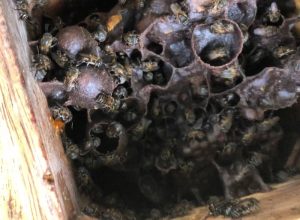 The jicote barcino, or melipona costaricensis is one of the three types of melipona bees that exist here in Costa Rica. The other two found here in Costa Rica are called jicote gato and jicote congo, but more on them another time! All of these Melipona bees are stingless.
The jicote barcino, or melipona costaricensis is one of the three types of melipona bees that exist here in Costa Rica. The other two found here in Costa Rica are called jicote gato and jicote congo, but more on them another time! All of these Melipona bees are stingless.
Jicote barcino are in danger of extinction. And yet, their honey is one of the most incredible things you’ve ever tasted – which you would think would drive more people to try and save them. Unfortunately, not enough people know about them and out of those who do, they don’t often know how to care for them.
Hive features:
The entrance to their hive is just large enough in diameter for one bee to pass at a time. So they need to coordinate the arrival and departure of their colony members with some pretty quick communication.

The inside of the jicote barcino hive, showing storage pods.
The honey and pollen storage is usually further into the hive than the nursery, meaning that the nursery is closer to the entrance of the hive.

The nursery, where all the eggs are kept.
This means that yes, they must cycle them down as time goes on – which is pretty incredible. It’s all scaffolded by a sort of thick paper-mud type of material, that chips away like bark, but gives a nice rigid structure for housing the next progenies.
The honey
Barcino’s produce substantially less honey than your honey-bee. Honey-bees have been recorded as producing up to 150 litres of honey a year! Whereas, with barcino’s, you’re looking at around a maximum of 4 litres per year being produced (not harvested). At most you’d collect about half the honey (no more than half). This ensures that they have enough food stored, should they need it, in times of flower/pollen/nectar scarcity.
The honey that barcino’s produce is out of this world. I still remember when I first tasted in. I nearly feel over – it was mind-blowing! It’s perhaps like a super sweet, yet super-light and floral honey. Like nothing you’ve ever tasted – and it may ruin regular honey bee taste for you. It’s also very high in antioxidants, as a bonus for the health status.
At the moment, we have 2 colonies of jicote barcino at the centre. Our intent is to have more. Hopefully you’ll get a chance to taste this divine honey, when you visit.
For more on bees, check out our bee archive here.